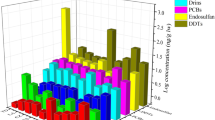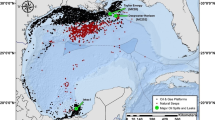Abstract
CONTAMINATION of marine fish by chlorinated hydrocarbons, especially by DDT and its congeners*, could threaten their future or continued utility as a food source if residues accumulate to the point of incipient toxicity on detrimental sublethal effects1. Little is known about the distribution of DDT residues in marine fish beyond listed concentration values for certain species. Most investigations have dealt with concentrations of residues in tissues or large pooled, unsorted samples of commercially caught fish (refs. 3 and 4; the latter covers exclusively marine studies). From this limited information, we know that fish of a single species caught 111 adjacent areas have markedly different contents of residues, probably because of differences in the magnitude of local sources of estuarine or airborne pesticides2–5. This heterogeneity of exposure poses problems for the interpretation of residue data from fish caught in these areas. In an attempt to obtain size-class data about concentrations of residues, relatively free from the effects of pesticide “hot spots”6, Triphoturus mexicanus, a midwater fish from an area relatively remote from areas of pesticide application, was chosen for analysis.
This is a preview of subscription content, access via your institution
Access options
Subscribe to this journal
Receive 51 print issues and online access
$199.00 per year
only $3.90 per issue
Buy this article
- Purchase on Springer Link
- Instant access to full article PDF
Prices may be subject to local taxes which are calculated during checkout
Similar content being viewed by others
References
Butler, P. A., in The Biological Impact of Pesticides in the Environment (in the press).
Risebrough, R. W., in Chemical Fallout, First Rochester Conference on Toxicity, 5–23 (Thomas, Springfield, 1969); Bailey, T. E., and Hanmen, J. R., J. Sanit. Eng. Div. Amer. Soc. Civil Engs., 93, 27 (1967); Butler, P. A., Bioscience, 19, 889 (1969).
Weaver, L., Gunnerson, C. G., Breidenbach, A. W., and Lichtenberg, J. J., Publ. Health Reps., 80, 481 (1965); Keith, J. O., and Hunt, E. G., Trans. Thirty-first North. Amer. Wildlife Nat. Res. Conf. 1966, 150–177.
Duffy, J. R., and O'Donnell, D., J. Fish. Res. Board Canada, 25, 189 (1968); Jensen, S., Johnels, A. G., Olsson, M., and Otterlind, G., Nature, 224, 247 (1969).
Robinson, J., Richardson, A., Crabtree, A. N., Coulson, J. C., and Potts, G. R., Nature, 214, 1307 (1967).
Keith, J. O., in The Biological Impact of Pesticides in the Environment (in the press).
Stanley, R. L., and Le Favoure, H. T., J. Assoc. Off. Agric. Chem., 48, 666 (1965).
Pesticide Analytical Manual, II (US Dept. Health, Education and Welfare, Food and Drug Administration, revised 1968).
Premdas, F. H., and Anderson, J. M., J. Fish Res. Board Canada, 20, 827 (1963).
Gakstatter, J. H., and Weiss, C. M., Trans. Amer. Fish. Soc., 96, 301 (1967).
Holden, A. V., J. Appl. Ecol., 3, Suppl., 45 (1967).
Author information
Authors and Affiliations
Rights and permissions
About this article
Cite this article
COX, J. Accumulation of DDT Residues in Triphoturus mexicanus from the Gulf of California. Nature 227, 192–193 (1970). https://doi.org/10.1038/227192b0
Received:
Issue Date:
DOI: https://doi.org/10.1038/227192b0
Comments
By submitting a comment you agree to abide by our Terms and Community Guidelines. If you find something abusive or that does not comply with our terms or guidelines please flag it as inappropriate.



